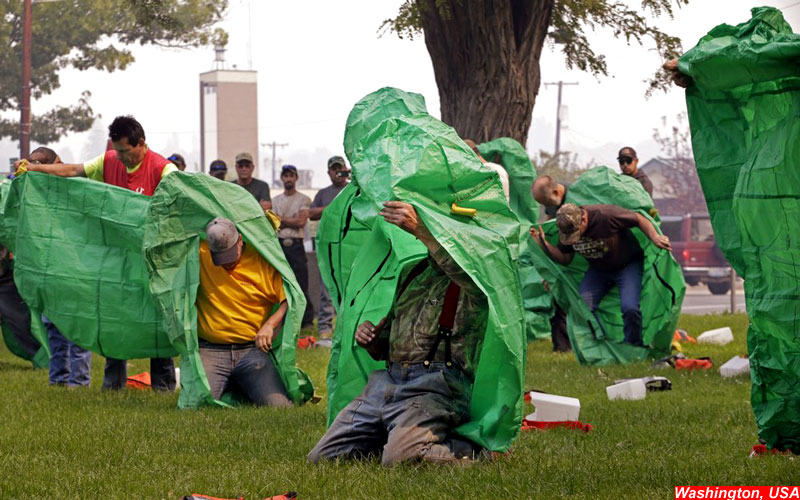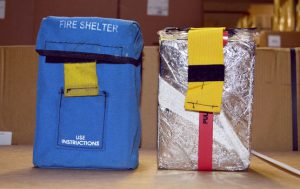
BOISE, Idaho (AP) — After flames trapped 14 firefighters in California and they had to use last-resort fire shelters to survive, questions are emerging about how well the emergency devices work and how often crews are forced to use them during wildfires.
“They are for an extreme emergency, never to be considered as an alternative to safe firefighting,” National Interagency Fire Center spokeswoman Carrie Bilbao said Wednesday. “They’re to be used as a last resort if there’s no planned escape out or safety zones become inadequate.”
Still, the shelters have saved more than 300 firefighters since they began being used in the 1960s and became required in firefighting equipment in the late 1970s, Bilbao said.
They look like oversized silver sleeping bags, weigh about 4.5 pounds (2 kilograms) and are made of an aluminum foil-woven silica outer shell designed to withstand direct flames and 2,000 degrees (1,090 Celsius) of heat for about a minute. The shelters don’t stand up well to direct flames or longer periods of heat exposure.
The U.S. Forest Service and other agencies spent years trying to create a better fire shelter, but all the prototypes were rejected last year after officials decided the current shelter provided “the most practical amount of protection given trade-offs of weight, volume (bulk), durability and material toxicity,” the National Wildfire Coordinating Group said.
The firefighters who used the shelters near Big Sur along the central California coast suffered burns and smoke inhalation Tuesday. Two were hospitalized in fair condition, and one in critical condition.
A wind-whipped blaze roared over a hill and overwhelmed them as they tried to protect their fire station, which was destroyed, Los Padres National Forest spokesman Andrew Madsen said.
“It’s a really harrowing experience for those who go through a close encounter like that, and we’re very grateful that the injuries are such that all three who were hospitalized are going to recover,” he said.
Three firefighters near Bozeman, Montana, also had to deploy fire shelters. After the wildfire passed last weekend, they walked to safety, were taken to a hospital and have since been released.

Fire shelters are occasionally redesigned to better withstand extreme conditions. At 500 degrees Fahrenheit (260 degrees Celsius), the glue that holds the protective layers together begins to melt. Crew members may have just seconds or minutes to find a safe spot to deploy the shelters, climb inside and manage to hold them tight to the ground despite the whipping gusts that often come with a wall of flames.
The last attempt at a redesign came in 2013, after 19 members of a 20-person hotshot crew from a Prescott, Arizona, fire department died despite using the shelters when a fire overtook them.
Over the next several years, the U.S. Forest Service and other state, federal and local representatives worked with researchers to review hundreds of different materials. Researchers came up with four prototypes that were tested in the field in 2018, two intended to be used by firefighters who work on the fire lines and two intended for firefighters who operate big equipment.
Some performed slightly better than the shelter used now but were ultimately rejected after failing production requirements or because they were heavier and bulkier.
Officials decided to stay with the current shelter, in part because of a decreasing trend in how often they were used. They also noted that none of the options could do the impossible.
“Regardless of size or weight, the research indicates that none of the prototypes would ensure firefighter survival in extreme fire conditions,” Dave Haston, chairman of the National Wildfire Coordinating Group’s equipment technology committee wrote in a March 2019 memo.
The current shelter was developed after the deaths of 14 firefighters who were overrun by flames on a Colorado mountain in 1994. The Colorado and Arizona disasters are among the deadliest for wildland firefighters since fire shelters became mandatory equipment in 1977.
____
Newsroom | theworldmail.co.uk
Source/Contribution/Photo Credit by Associated Press






